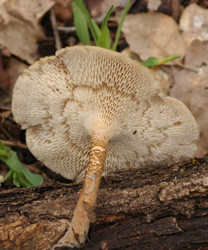Fungal enzymes for industrial applications
Enzymes are proteins with biocatalytic activity that can speed up the rate of various chemical reactions with exquisite substrate specificity. With the advent of genetic engineering, enzymes can be produced at large scale and adapted to industrial applications. Given that they are more environmentally friendly than chemical reagents, enzymes — and especially hydrolases — are increasingly being used in various industrial sectors. Oxidoreductases are another enzymatic family that has received much attention during the last years due to its ability to catalyse the transfer of electrons among different substrates in redox reactions. However, the penetrance of redox enzymes in the industry is very low mainly because some of the most promising ones have only been recently discovered. In nature, several fungi such as lignocellulose-degrading basidiomycetes contain peroxidase enzymes that help them attack plant biomass, and are responsible for the natural recycling of most of the carbon in land ecosystems. They represent a potential source of industrially relevant oxidoreductases that were investigated in the EU-funded project 'Novel and more robust fungal peroxidases as industrial biocatalysts' (PEROXICATS) aimed to provide the EU industry with new peroxidase-type robust biocatalysts of diverse catalytic properties. In this context, scientists screened a variety of fungal cultures from specific/extreme habitats to obtain enzymes with oxidoreductase activity. An in silico search of recently sequenced fungal genomes also led to the discovery of new families of oxidoreductases enzymes which most promising candidates were subsequently evaluated for their catalytic activity after heterologous expression. By performing a structure-to-function analysis, scientists were able to further improve enzyme performance (operational and catalytic properties) by rational design or directed evolution. Numerous biotransformation reactions catalysed by the newly identified enzymes were characterised, demonstrating the potential utilisation of these enzymes in the chemical or pharmaceutical sector. Incorporation of the PEROXICATS biocatalysts in various industrial processes will translate into cost reduction and more environmentally-friendly biotechnological transformations. Evaluation of these candidate enzymes in medium- and large-scale applications is currently underway by the EU-funded successor project INDOX.
Keywords
Fungal enzymes, biocatalytic activity, oxidoreductases, fungal peroxidases, heme-peroxidases, industrial biocatalysts, biotransformation



